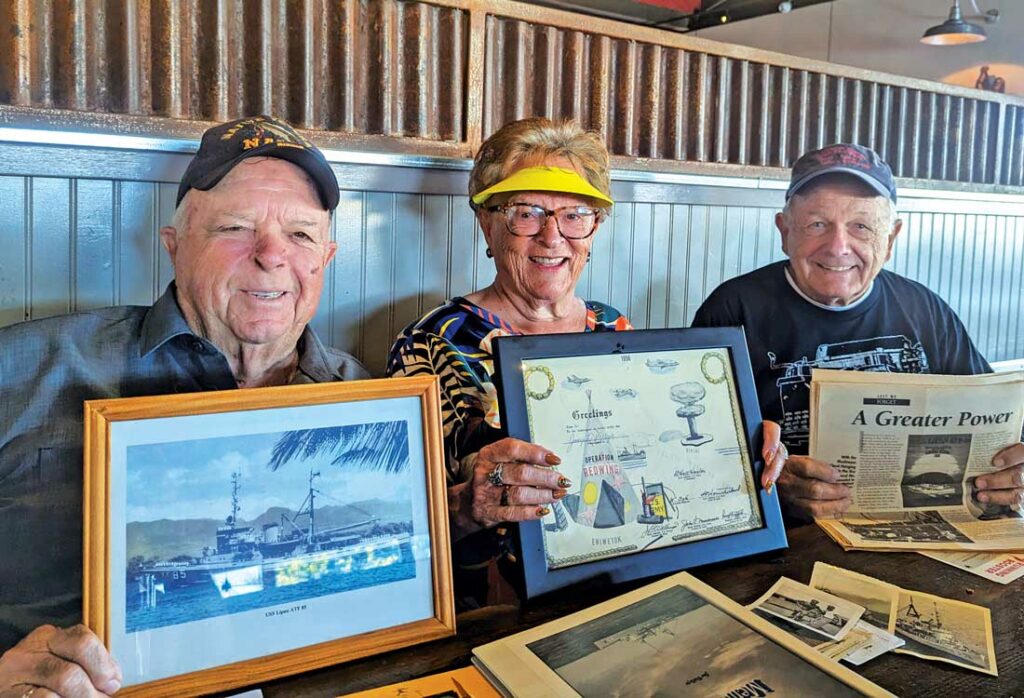Joe Vallejo braced himself on the deck, pulling down his hat with both hands to cover his eyes. Then the countdown started. Transmitting over the radio speakers of the U.S.S. Lipan, the crew in the airplane above counted off the last seconds.
Suddenly, everything went white. Vallejo could see the bones in his legs, the x-ray effect from the awesome light that swallowed everything. When he turned around, a burst of purples, greens and reds filled the pre-dawn horizon over the Pacific Ocean. Immediately after, a shock wave raced across the water and shuddered the boat.
The year was 1956 and Vallejo had just experienced the tremendous power of a hydrogen bomb detonation.
“I was scared,” Vallejo says. “I didn’t know what was going on.”
Born and raised in Hollister, Vallejo, now 91, enlisted in the U.S. Navy soon after high school, at the outset of the Korean War. Recently married to his high school sweetheart, Rosemary, Vallejo found himself in the Marshall Atoll islands as part of Operation Redwing. The operation consisted of 17 hydrogen bomb tests from May to July 1956 during the height of the Cold War.
Back on the U.S.S. Lipan, a Navajo-class fleet tug vessel, Vallejo sailed the crew to retrieve a barge that had been placed at the blast’s epicenter 30 miles away. Then, the crew donned rudimentary protective gear as they washed down the barge so Navy scientists could test it for radiation. At the time, the effects of radiation were not fully known and tests like these were conducted to determine if it could simply be washed off.
Also aboard the ship was John Lesjack from East Detroit, Michigan. He served with Vallejo for the duration of Operation Redwing. Lesjack, now 87, remembers when he and Vallejo first became friends after taking a trip to their island base to get their mail. Vallejo was desperate to find a letter from Rosemary.
“We’re going back to the ship and there’s Joe shaking the bags saying ‘Where the hell is it?!’,” Lesjack says.
Lesjack found it humorous and teased Vallejo. They laughed it off and became friends.
Now, they both sit in a downtown Hollister eatery decades later, the table strewn with photos and newspaper clippings documenting their experiences. Oh, and Rosemary is there too. She and Joe have been married for 67 years. Vallejo retired as a butcher after settling back in Hollister and starting a family.
Lesjack moved out to California and retired as a school teacher in 1996. It was then that he began searching for his shipmates from the Lipan, using the advent of the worldwide web to aid his efforts. He eventually tracked down Vallejo and others. Out of the 70 crewmen, only eight of them are still alive.
However, the survivors are living with the effects of severe radiation exposure. Both Vallejo and Lesjack have skin cancer and Vallejo, at the time of this interview, had recently undergone a procedure to remove a cancerous growth.
He says that while the scientists wore proper protective gear during the blasts, he and his crew bore the brunt of the exposure.
“You’re still breathing the radiation. And that’s why I’ve got this (stuff) on me, but they don’t recognize it,” Vallejo says.
Vallejo claims that the Department of Veteran Affairs has refused to give him and others disability compensation for their condition. He was told that in order to qualify for compensation the cancer had to affect internal organs.
Lesjack, who now lives in Santa Rosa, has also undergone surgery on his face due to his skin condition. He points to the visible scar on his nose. He mentions the case of another Lipan shipmate who has undergone 63 procedures on his body to treat the skin cancer.

“I don’t like to talk about the bomb,” Rosemary says, speaking about Joe’s experience. “Because I know that his face, his head and what he’s got in his blood, they’re not doing anything about it and a lot of his friends have died.”
When asked to look back on their contribution to the development of atomic warfare, Vallejo and Lesjack have different views
“I’m a veteran for peace and I can’t see any point to war, except it makes the rich man rich,” Lesjack says.
Vallejo thinks that in a time when nuclear non-proliferation treaties are being scrapped and other nations are competing with U.S. stockpiles, these weapons are necessary.
“You gotta have them. Everybody else has them,” Vallejo says.
Reflecting on the significance of Veterans Day, Lesjack says that veterans need to be remembered for their contributions, if only once a year.
“Veterans Day reminds us that we did stuff for our country, it doesn’t mean just a free lunch at Applebee’s,” Lesjack says.
Aside from teaching in the years after leaving the service, Lesjack also became a writer. In a piece from May 2001 titled “A Greater Power,” he conveyed how he felt after his time on the Lipan:
Finally, on a very warm day in July, we witnessed our fifth and final detonation of Operation Redwing, quietly weighed anchor and steamed back to Pearl Harbor, Territory of Hawaii. The barge we had towed for 17 days and nights stayed in the Marshall Atolls. We also left behind a hole in the earth unimaginably deep, and the entire area was now radioactive, but we had survived. We had survived!











Dear Editor,
I like how reporter Josue Monroy handled the story about “Atomic Survival.”
Is that reporter related to the Josue Monroy who plays drums in the rock band,
“The Atomic Aces?”
If so, is he interested in writing a story about a woman who was married just before
the ships were attacked in Pearl Harbor, Hawaii, December 7, 1941, a “day of infamy,”
as FDR said.
John J. Lesjack
Santa Rosa, CA
I